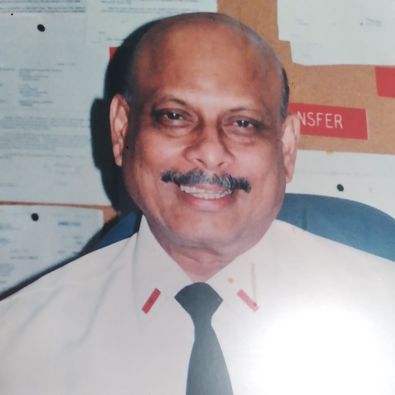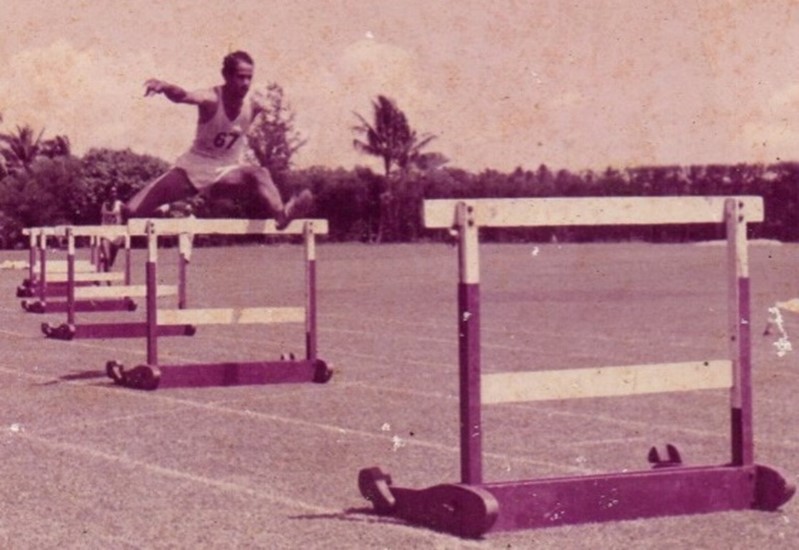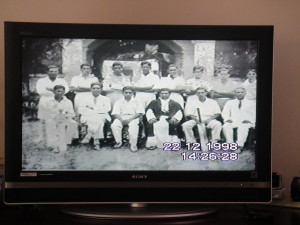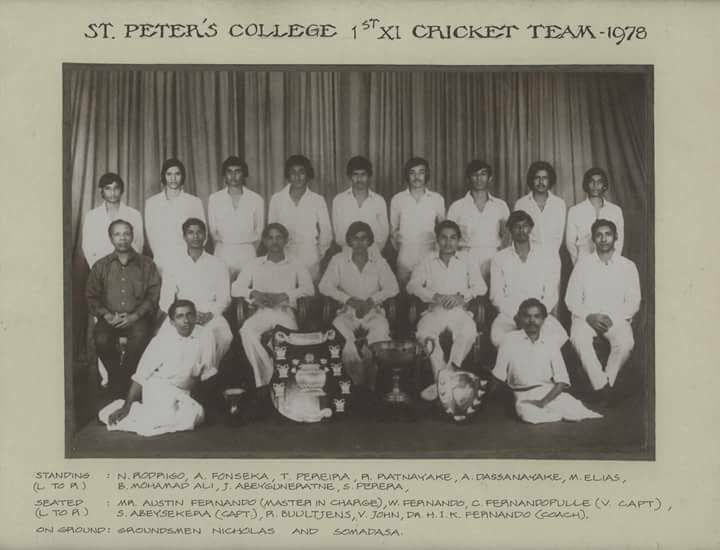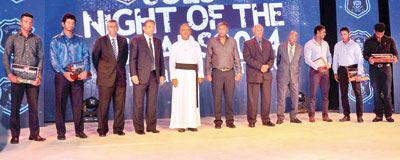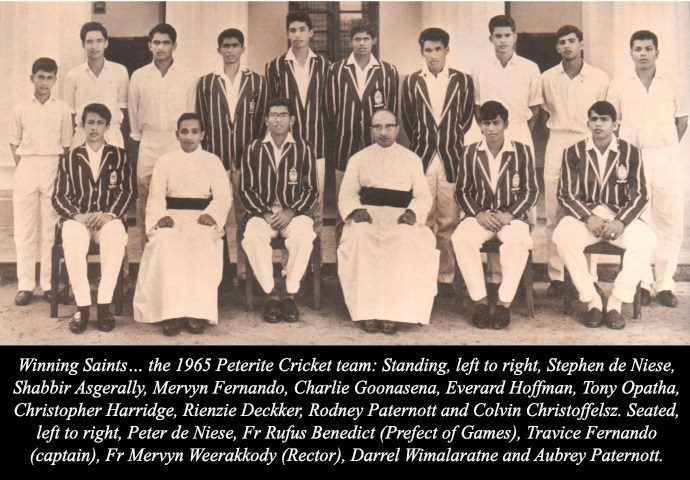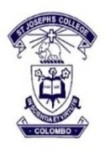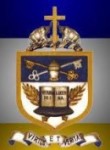St. Peter's College was founded in 1922, and cricket was introduced in 1927. The first "big match" was played in 1933 with the Josephians winning the inaugural game by an innings and 105 runs. It took 13 years for the Peterites to register their first win in the series. This was in 1946, under the captaincy of legendary Dion Walles who had a nucleus of good cricketers in the team – Bernard Wijetunga (Sr), Wicket-keeper Harold de Silva, Maurice Perera, Neville de Silva, Mike Chanmugam and Shelley Wickramasinghe. The Joes were led by Neil Weerasinghe who suffered their first series defeat by 7-wickets. For posterity, Dion Walles led the Peterites to a sensational innings win in the 14th encounter as well in 1947 to record successive wins for the Peterites. Skipper Dion Walles had the services of many senior players in 1947 – Bernard Wijetunga (Sr), Neville de Silva, Mike Chanmugam, Shelley Wickramasinghe and O. S. Peiris. Darrell Weinman, Hugh Fernando, Douglas Fernando, M. Van Arkadie were freshers in the winning team.
Subject to correction, Anton Perera (1944 & 1945) – Dion Walles (1946 & 1947) – H.I.K. Fernando (1951 & 1952) – Clive Inman (1954 & 1955) – Roy Dias (1971 & 1972) are the only Peterites to have had the honour of captaining St. Peter's College in Cricket twice. A rare and unique honour that rarely occurs now, in the new millennium. Kudos to these players who led from the front and stamped their class as good leaders!
By: Upali Obeyesekere – Toronto, Canada
Getting back to the subject matter, 44th Battle of the Saints encounter in 1978 was played on March 17th & 18th at the Colombo Oval. Joes were captained by Shamilal de S. Wijeratne while Peterite skipper was Suraj Abeysekara. Both teams fielded experienced players who later became household names. The Josephian team comprised of skipper Shamilal de S. Wijeratne, Rohan Wijesinghe (Jr), Michael de Silva, R. Gurusinghe, Cleophus Lord, Viraj Perera, Raymon Lord, Anil Fonseka, Lakshman Aloysius, R. Paiva and N. Weerasinghe. The Peterites were led by Suraj Abeysekara, an effective off-spinner who played club cricket later for BRC and also secured a berth in the Sri Lanka 'A' team. Opening for the Peterites were A. Fonseka and consistent run-getter Michael Elias. Christopher Fernandopulle, fondly known as "Kitto" was Vice Captain and came in at No.3, followed by another brilliant bat – Rohan Buultjens who scored centuries in both innings in 1979. Trehern Pereira and Walter Fernando summed up the top order with skipper Abeysekara, Vinothen John (needs no introduction, having won his 'Ceylon Cap' soon after), Niranjan Rodrigo, B. Mohamedally and A. Dassanaike.
Team photos are shown below, which enables our readers to put a face to the name. The Peterites had some big names in this 1978 team, players who made a positive impact to the game and provided leadership in later years. Kitto Fernandopulle captained SPC in 1979, Rohan Buultjens in 1980, Michael Elias in 1981, Niranjan Rodrigo in 1982.

 Josephian skipper Shamilal de S. Wijeyeratne won the toss and elected to bat. Opener Rohan Wijesinghe (Jr), 32, Michael de SIlva, 58, N. Weerasinghe, 14, R. Gurusinghe, 25, batted well to take the Joes to 217 for 9 wkts. In reply, the Peterites scored 161 runs with Rohan Buultjens, 73, anchoring the side with a flawless half-century. In the 2nd innings the Joes made a sporting declaration at 127 for the loss of 6 wkts leaving the Peterites to score 183 runs. The Peterites accepted the challenge head-on reaching the 183-run target in 40 overs, by scoring slightly over 4 runs an over. Looking at the scores, there were two stars who made this happen. One was Kitto Fernandopulle and second was Rohan Buultjens who had a good double. Kitto Fernandopulle top scored for the winners in the 2nd innings with an unbeaten knock of 65 runs. Rohan Buultjens, 49, was unfortunate to make his second half-century. Walter Fernando also picthed in with a well compiled 42 runs to help the Peterites round up a six-wicket victory. In the bowling department, A. Dassanayake bagged 5 for 34 for the Peterites, Vinothen John 3 for 14, skipper Suraj Abeysekara 3 for 51 and 2 for 31. A well deserved win for the Peterites.
Josephian skipper Shamilal de S. Wijeyeratne won the toss and elected to bat. Opener Rohan Wijesinghe (Jr), 32, Michael de SIlva, 58, N. Weerasinghe, 14, R. Gurusinghe, 25, batted well to take the Joes to 217 for 9 wkts. In reply, the Peterites scored 161 runs with Rohan Buultjens, 73, anchoring the side with a flawless half-century. In the 2nd innings the Joes made a sporting declaration at 127 for the loss of 6 wkts leaving the Peterites to score 183 runs. The Peterites accepted the challenge head-on reaching the 183-run target in 40 overs, by scoring slightly over 4 runs an over. Looking at the scores, there were two stars who made this happen. One was Kitto Fernandopulle and second was Rohan Buultjens who had a good double. Kitto Fernandopulle top scored for the winners in the 2nd innings with an unbeaten knock of 65 runs. Rohan Buultjens, 49, was unfortunate to make his second half-century. Walter Fernando also picthed in with a well compiled 42 runs to help the Peterites round up a six-wicket victory. In the bowling department, A. Dassanayake bagged 5 for 34 for the Peterites, Vinothen John 3 for 14, skipper Suraj Abeysekara 3 for 51 and 2 for 31. A well deserved win for the Peterites.
SCORES: SJC 217/9 and 127/6 lost to SPC 161/8 and 187/4 by 6 wickets.
SJC 217/9 wkts declared – Rohan Wijesinghe (Jr.) 32, Lakshman Aloysius, 32, Michael de Silva, 58, R. Gurusinghe, 25 and 127/6 declared – C. Lord, 19, Anil FOnseka, 16, Viraj Perera, 21 n.o. and Michael de SIlva, 15 n.o. SPC 161/8 wkts declared – Rohan Buultjens, 73 and 187 for 4 wickets – Kitto Fernandopulle, 65 n.o.; Rohan Buultjens, 49, Walter Fernando, 42.
This article would not be complete sans mention of a brilliant piece of writing by Michael Elias under the caption, "Platinum Years of Peterite Cricket 1978-1980". Michael has recounted his experience playing for St. Peter's College in 1978, 1979, 1980 and captaining in 1981. Article reproduced below as I found it extremely informative and well written. Thanks Michael.
The Platinum Years of Peterite Cricket 1978-1980 by Michael Elias
Reams have been written about the "Golden Years" of Peterite and Josephian cricket. Countless arguments for and against one particular "greatest" era or a specific team have been made and are still being made whenever Peterites or Josephians meet.
For many years we were very fortunate to have had the contributions of two very special people – the legendary cricketer, teacher, coach and commentator the late C. E. Maurice Pererea of St. Peters (1944 – 1946) and the late T. Harold De Andrado statistitian extraordinary of St. Joseph’s, who did not play a "Big Match" but was a reserve in 1944 and 1946. Together, they provided a great depth of articles for several cricket souvenirs of the past and their commitment, knowledge and lucidity have been the backbone of Peterite/Josephian cricket literature. Each of them had their preferences and I who had the privilege of knowing both, have had many amicable discussions, mostly sober but some I must admit coloured with a few spirits, on the merits of their views while putting forward those of mine and those of a few colleagues like Kitto Fernandopulle, captain of the 1979 side who can become a bit vociferous in his lament that nothing has ever been written about the glorious years we trod the turf. I suppose Perera and De Andrado put up with the young upstart who argued with them only because I had acceptable credentials – having been 12th man in 1977, played the entire seasons of 1978-1980 and captained in 1981.
So this is a tribute to the brilliant Peterite teams of 1978-1980, the Platinum Years and I hope the facts presented will find the approval of the two great men, who no doubt will be watching from above the future of many generations of Peterite and Josephian cricketers now and for evermore.
For after all, and whatever anyone else says, at no period in the history of the game has any other team, either Peterite or Josephian produced three Test players, two who shared the new ball for Sri Lanka – Rumesh Ratnayake and Vinodhan John and the other Amal Silva, opened batting. In addition, Kitto Fernandopulle opened batting for Sri Lanka Schools and scored 58 against the Australian Schools team, Rohan Buultjens captained Sri Lanka Schools against the Indian Schools and the Dutch team and subsequently toured India with the Sri Lanka Test team, Suraj Abayasekera played for Sri Lanka ‘A’ while Trehern Perera and myself were also chosen for the trials of the Sri Lanka Schools squad.
The Test caps were not mere ornaments either. Amal Silva scored a century at Lord’s against England and still holds the record for the most number of victims in an international Test series, which was against India and this in a three Test series! Vinodhan John and Rumesh Ratnayake’s exploits are well known by all. While the fearsome fast bowlers of the past were probably very quick, there is no factual evidence that they could have taken out several of the world’s top batsman and like Rumesh (though he is not proud of it), hit Larry Gomes on the face, hit the towering Clive Lloyd on the head and in fact caused that most brilliant of players, Viv Richards who usually disdained a helmet, to don one. Rumesh’s ability to make a ball climb very steeply and follow up with a toe crunching yorker brought him over 100 wickets in a school season with more than 50% being bowled. Match bags of over 10 wickets were common and taking over four wickets per inning in almost every match, he was terrifying. I had to rein him in on several occasions to prevent serious injury. There were no helmets those days. Always good natured and concerned, he would very rarely bounce at anyone during school matches, but on many occasions while fielding at first slip, I would dive to catch a bail he had sent flying or on two occasions even caught a cart wheeling stump. One of the few to play for his country as a fast bowler while still at school, but his versatility may have been forgotten as he was also a deadly right arm leg spinner who took three wickets in a big match with spin – all three victims were stumped by Amal.
Also, while there were many great all rounders in past Peterite and Josephian teams, with all due respect, they did not play truly representative cricket against the world’s top teams and no one has conclusively proved his class by taking five wickets and scoring a half century on his debut – at Lord’s, like Rumesh did. Rumesh is today the representative of the Asian Cricket Council and is responsible for the development of cricket in several countries.
Vinodhan’s movement in the air and off the wicket had to be experienced to be believed and given the right conditions he was unplayable – as a shell shocked Royal team discovered when he ran through them with figures of 6 for 14 in 1980. Match bags of 10 wickets each against Thurstan and Trinity gave him the highest number of wickets in 1980 – 54 at 14 runs apiece.
Anyone who was around during this period will not challenge the fact that Rohan Buultjens was one of the best batsman of the period – winning the Schoolboy Cricketer of the Year and Best Batsman, 1000 runs in a season, two centuries both ‘not out` in the Big Match, the Big Match record of the best batting double, the Second best batting double for St. Peter’s, the highest aggregate in the series, the record third wicket partnership of 173 with Kitto Fernandopulle which stands to this day and countless other centuries and half centuries against most other schools. His total command over any bowler of the era backed by hard facts clearly indicates the travesty of justice that kept him out of the Sri Lanka Test team. Though primarily a batsman, Rohan who also captained in 1980, picked up several crucial wickets, specialising in breaking partnerships.
Kitto Fernandopulle, the master strategist was easily one of the best cricketing brains – proved by the umpires’ panel awarding him the Best Captains Trophy in 1979. His half century against the Aussies had commentators raving about "late cuts like Sathasivam." Kitto is today the Second XI coach of St. Peters and is doing a great job at developing cricketers having already fed the First XI team with three players this season.
Amal Silva, my opening partner for two of these years was the rock on which we built many of our totals. Over 700 runs in his first year (1979) and reaching the 1000 in the big match of 1980 with the second highest score of 144 not out made him an obvious choice to open for Sri Lanka . Incidentally, our partnership of 97 for the first wicket still stands as the highest for St. Peter’s. A brilliant wicketkeeper who made catching and stumping look very easy, and though I cannot remember how many victims he had, with Rumesh and Vinodhan firing thunderbolts from either end. There must have been many.
Known as the "Black & White" Scotch Wiskey combination – Amal with his Caribbean tan and cavalier style and me with my pale face and dour/solid English style temperament, though I did show a few rare flashes of belligerence with three sixes in big matches one onto the Kandos advertisement near the scoreboard and another sweet shot off Hiran Cooray which had the commentators ducking for cover. A few more of these rare shots were against other schools and one I particularly liked was against Royal at Bambalapitiya which hit the wall of Muslim Ladies’ College – must have been due to my rather heavy bat which was a custom made Gray Nicholl’s Single Scoop with 12 gram willow.
1980 saw some of the best starts any pair of openers have ever given the side as we put together a half century stand in 15 out of 21 innings, at least one against every school except Royal College and at the Benedictine match put on a century stand in each innings. Strangely Amal never took strike in college and I always batted at No 1, but for Sri Lanka he regularly faced the first ball.
Other than captaining in 1981, my primary contribution was supporting partnerships and yes I have another good one – 179 against Royal in 1978 with Kitto who scored 104, run out – the only way they could get him. On the other hand I did make a few small contributions with 3 centuries (a top score of 148 vs St. Anthony’s in 1980) and a few fifties – though my highest scores at Big Matches were 39 and 31.
The two most experienced cricketers of the 1978 side were Suraj Abaysekera the skipper, a wiley off spinner who subsequently played for the BRC. Suraj played as the main spinner for Sri Lanka "A" and was called up several times for Sri Lanka trials but could not make it to the final Test 15. Incidentally Suraj who was second highest wicket taker in 1978 fittingly scored the winning runs of the historic Big Match victory.
The other was Walter Fernando a superb all-rounder with a classic action and unbelievable accuracy who bowled the perfect late out swinger to right handers. With over 50 wickets at an average of 11.3 and a batting average of over 30 per inning he was easily the most valuable player of 1978. Walter represented Sri Lanka Schools and subsequently played for and captained the Tamil Union.
With three half centuries to his credit Niranjan Rodrigo who captained in 1982 was a solid middle order bat and right arm leg spinner with best figures of 5 for 17 against Isipathana in 1980. Niranjan took 23 wickets at 14.6 in 1978 and scored an unbeaten 100 against the Bens in 1982. A brilliant cover fielder it was always a treat to watch him gather and throw with perfect fluidity. The third seamer in 1978, left armer Ajith Dassanayake wrote himself into the record books with an excellent 5 for 34 and contributed another very significant and match winning stroke for 6 over square leg when 6 runs were needed off two balls to win the Exide trophy final. Ajith also took over 40 wickets in the next two years and scored a half century vs Royal in 1980.
Trehern Pereira who opened the batting with me in 1981 batted in the middle order between 1978 and 1980 with one century against Royal College and three 50’s. He was also a very accurate off spinner who was the principal contributor to the 50 over victory in 1981 with 3 wickets for 19 runs in 10 overs effectively choking the Josephian batsmen.
School cricket in the late 70’s and early 80’s had advanced to a very high standard and Sri Lanka was on the threshold of test cricket. Gearing up for "Tests" more ".professional"’ batting, combined with good quality wickets and more evenly matched teams meant outright wins in two days were rare. In fact, the Royal/Thomian 03 day fixture had just started and batsman like Sumithra Warnekulasuriya of Royal batted two full days for a 100 runs. Yet, between ‘78 and ‘80 St. Peters had fourteen outright wins including St. Josephs, Royal, St. Thomas , Trinity, St. Anthony’s, St. Benedicts, Thurstan, Isipathana and Dharmapala. Some of them after a lapse of many years like St. Thomas ’ which was an 8 wicket victory in a match where 2 1/2hrs of play was lost due to rain. In the great Big Match victory, two very sporting declarations threw the match open – we declared 56 runs behind St. Josephs and the Joes closed with very little hope of winning. We chased 187 runs and got it in 40 overs in the 17th mandatory over in failing light. It should be remembered that our run rate of almost 4.7 runs per over was almost double that of the previous 10 innings at the Big Match which had an average of only 2.5 runs!
We bowled out Prince of Wales College for 33 runs, Ananda 34 and 94, Nalanda 67, Royal 50, St. Thomas ’ 111, Dharmapala 43 and Thurstan for 77. Scored 304 for 3 against a very strong Royal side which subsequently had three Sri Lanka test bowlers and destroyed a mighty Royal batting line up for 50 runs, the same side that gave the Joes a leather hunt by scoring 379 for 6 wickets, two weeks later!
The only Peterite or Josephian side in history to have won both the Big Match and the 50 over. Champions in 1978, 1980 and 1981. Awarded Best All Island Team by both Observer and Times sponsored panels. Won the first ever all island knockout limited over cricket trophy where over 50 teams participated. Best Captain three years on the trot, Best Batsman, Best Bowler etc, etc, etc.
This then is what I proudly refer to as the "Platinum Years" of Peterite cricket…..
And before any reader comments that the opposition may have been of poor quality let me set out the galaxy of stars who played against us and put the argument to rest – Ranjan Madugalle (International match referee), Ashantha De Mel, Sudath Pasquel, Ramesh De Silva, Kesera De Costa, Haroon Musafer, Rohan Jurangpathy, Gehan Sonnadara, Sumithra Warnakulasuriya of Royal, Guy De Alwis, Saliya Ahangama, Ken De Alwis, Mahinda Halangoda, Stefan Anthoniz of St. Thomas’, Ravi Ratnayake of Trinity, Roger Wijesuriya of St. Sebastians, Nishantha, Dammika, Sanjeeva and Arjuna Ranatunga (Captain of Sri Lanka), Roshan Mahanama (Test record partnership and International Match referee), Sanath Kaluperuma, Asanka Gurusinghe, Charith Senanayake, Brendon Kuruppu (Test Double Centurion and present Manager of the Sri Lanka team), Hemantha Devapriya and Kamal Dharmasiri among otherss.
Many of these have played for our country in Test or One Day Internationals or been on trial for Sri Lanka or Sri Lanka school teams. I may have left out a few top players and to them – my sincere apologies.
Other members of the "Platinum Years" teams were left arm spinners Janaka Abeygunaratne (77-80) and Roshitha Perera (80-82) who took 31 wickets at 14.7 in 1980, Wicketkeeper/ Opener Arjuna Fonseka (1978) who had four half centuries, batsman Bakir Mohamedally (78-79), Chrishanthus Peiris (1979), Sugath Perera (78-80), Christopher Perera (80-81), Suren Perera (1979), Rohan Paulas (1980-82) who scored 55 against Royal in 1980 and scored heavily in later years including a century in 1982, Dane Joseph (1980-82) who also scored a century in 1982 and seamers Ernest Fernando (1977 and 1980), Sarath Perera (1980) and Abdul Razak (1980).
The teams were coached by Brig Dr. H. I. K. Fernando (1978 and 1979) and Tony Opatha (1980) assisted by Brian Seneviratne and Master In Charge Austin Fernando. At the helm of St. Peter’s was the much revered Rector, Fr. Joe E. Wickremasinghe, who sadly passed away a few years ago.
Today, members of the "Platinum Years" teams have scattered far and wide while some have even crossed the great divide. I have not had the fortune to watch many of the great players of the past – Clive Inman, Dion Walles (who I now meet regularly) Malcolm Spittel, Cyril Dias, Fred Perera, Robert Fernando, Malcolm De Costa, Laddie Outschoorn, Hubert Bagot, Joe Misso, Johnpulle, Peter De Neise, Adiel Aunghie, Russel Duckworth, Fairly Dalpathado, Maurice Perera, Dr. H. I. K. Fernando, Fr. Joe De Mel, Shirly De S. Illesinghe and Michael Chanmugam (who coached me), Travel Fernando (the President of the Cricket Foundation of St. Peters), David Arndt, Tony Buhar and Brian Seneviratne to name a few, of whose exploits we have only been able to read or hear with joy and appreciation.
However, most players of our era have been able to watch David Heyn, Tony Opatha, Roy Dias, Gary Melder, Rajiv Benedict and all those others who played school cricket from the late sixties. We and all present and future cricketers of our two great schools owe a profound debt of gratitude to these heroes for they have been a shining example to us.
by Michael Elias 1980
Like this:
Like Loading...




